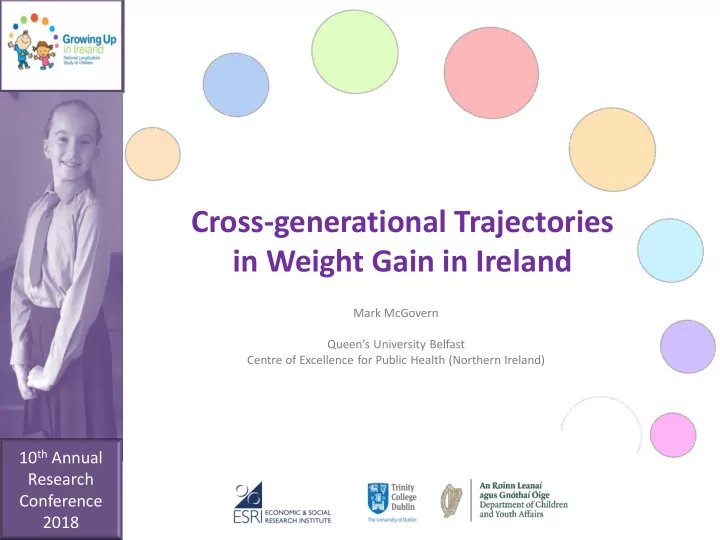

Cross-generational Trajectories in Weight Gain in Ireland Mark McGovern Queen’s University Belfast Centre of Excellence for Public Health (Northern Ireland) 10 th Annual Research Conference 2018
Weight Status among GUI Child Cohort
Background • Weight status impacts not just on the health/wellbeing of individuals, but also has wider implications • Including health service externalities • Economic impact is one example • Estimates of societal costs generally large (e.g. Tremmel et al., 2013)
Economic costs of obesity in Ireland • Safefood report “ What are the estimated costs of childhood overweight and obesity on the island of Ireland? ” – Perry et al (2017) • Total lifetime cost of €4.6 billion • Around 20% due to direct costs, other 80% due to indirect costs associated with morbidity and mortality • Key issue is persistence of weight status
This paper • Given persistence in childhood weight status, key question is whether there are any factors which predict difference in trajectories in early life • This paper examines the extent of covariation in child and parent weight • GUI infant cohort • Descriptive and preliminary
Previous literature on Ireland • Keane et al (2014) – high and stable rates of obesity among children in Ireland • Gender and SES gradients in overweight/obesity are substantial (Madden, 2016; Walsh and Cullinan, 2015) • Childhood overweight/obesity predicts GP and hospital inpatient stays at age 13 (Doherty et al, 2017) • Relationship between parental classification of child weight status, own weight status, and education (Cullinan and Cawley, 2017; Queally et al, 2018)
Measurement • Even with “objective” data, measurement of weight status is controversial even among adults, especially with regards to hard cut- offs (e.g. O’Neill, 2015) • For children, measurement should additionally take account of standard age and gender-specific growth trajectories • Puberty is particularly problematic • Number of different approaches, mainly based on growth curve analysis (e.g. for the UK - Cole, 1995)
Measurement • In this paper I use the WHO reference standards (WHO, 2006), but assessing sensitivity to alternatives is key • Analysis mainly based on WHO derived weight for age Z score • +1 SD taken as indicating overweight status • Leads to classification of more overweight than International Obesity Task Force (IOTF) at younger ages • Advantage is easier to compare across cohorts and account for birth weight (McGovern, 2018)
Distribution of Weight for Age Z Scores GUI Infant Cohort .4 .3 .2 .1 0 -5 0 5 Weight for Age Z Score Wave 1 (9 months) Wave 3 (60 Months)
Child Weight for Age (at 9 months) 1 .8 .6 .4 .2 0 18.5 25 30 Maternal BMI (Wave 1)
Parental BMI Transitions W1 – W3 Mother's BMI Category in W3 18.5-25 25-30 30+ Total W1 % % % % BMI 18.5-25 73 24 3 100 Category 25-30 15 66 20 100 30+ 3 20 77 100 Father's BMI Category in W3 18.5-25 25-30 30+ Total W1 % % % % BMI 18.5-25 61 38 2 100 Category 25-30 9 77 15 100 30+ 2 18 81 100
Summary of Parental Weight Changes W1 – W3 Mother's Change in Weight Status No. % Stayed NW 2470 38 NW to OW/OB 894 14 Stayed OW/OB 2743 43 OW/OB to NW 331 5 Total 6437 100 Father's Change in Weight Status No. % Stayed NW 912 17 NW to OW/OB 588 11 Stayed OW/OB 3568 67 OW/OB to NW 252 5 Total 5321 100
Maternal and Child Weight Status Change Boys Mother's Change in Weight Status Child changed to OW/OB Category in W3 Stayed NW 6% NW to OW/OB 8% Stayed OW/OB 11% OW/OB to NW 5% Average 8% Girls Mother's Change in Weight Status Child changed to OW/OB Category in W3 Stayed NW 4% NW to OW/OB 7% Stayed OW/OB 10% OW/OB to NW 5% Average 7%
Paternal and Child Weight Status Change Boys Father's Change in Weight Status Child changed to OW/OB Category in W3 Stayed NW 5% NW to OW/OB 7% Stayed OW/OB 8% OW/OB to NW 2% Average 7% Girls Father's Change in Weight Status Child changed to OW/OB Category in W3 Stayed NW 4% NW to OW/OB 7% Stayed OW/OB 8% OW/OB to NW 5% Average 7%
Regression analysis • We are interested in understanding whether changes in parental weight are associated with changes in child weight • There are many ways to approach this, here we focus on a descriptive analysis • Does change in parental BMI predict changes in childhood weight for age (W1 – W3) after other factors are accounted for? • Standard panel approach, with FE accounting for additional fixed family characteristics • Other controls: smoking, age, education, household size, income, employment
Regression Results Weight for Age Z Score RE RE FE FE Variables Boys Girls Boys Girls Mother's BMI 0.0125*** 0.0166*** -0.00590 0.00190 (0.00316) (0.00295) (0.00672) (0.00612) Father's BMI 0.0263*** 0.0248*** 0.0134 0.00569 (0.00402) (0.00355) (0.00863) (0.00755) Other Controls Y Y Y Y Observations 5,913 5,650 5,913 5,650 Number of ID 3,559 3,445 3,559 3,445 Robust standard errors in parentheses *** p<0.01, ** p<0.05, * p<0.1
Next steps • Compare with other measurement approaches for child weight status • Reverse causality and lags • Examine the role of other predictors of childhood weight change • Incorporate W4 (although limited) and birth weight • Potentially use child cohort
Limitations • Very preliminary! • Data are weighted, but attrition remains a concern • Measurement of childhood weight status/gain is not straightforward • Mean reversion
Thanks! • Email: m.mcgovern@qub.ac.uk
Recommend
More recommend